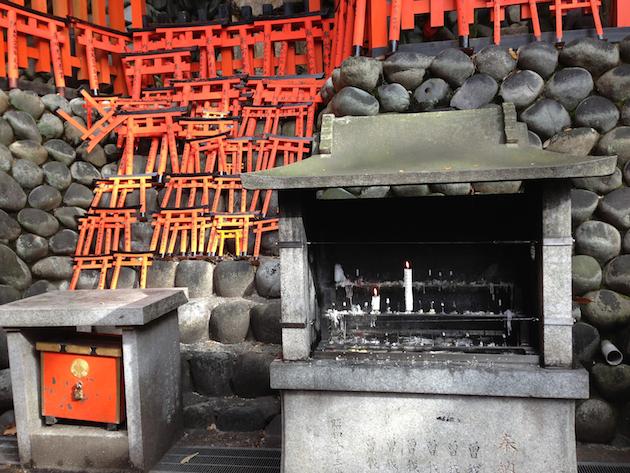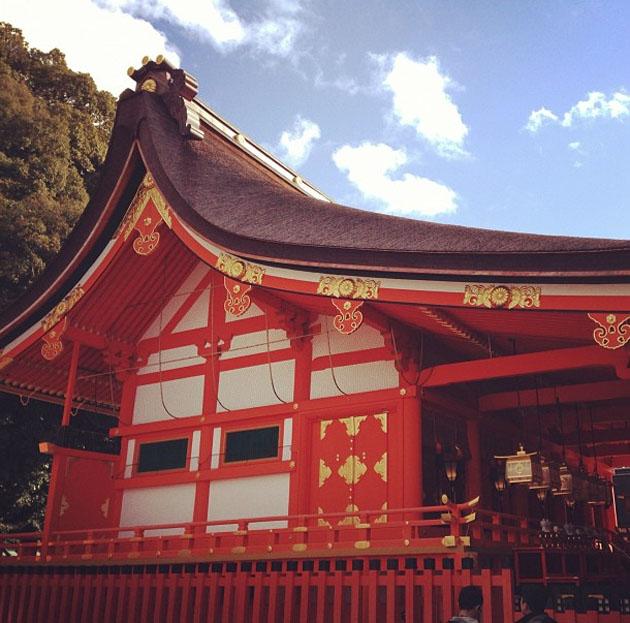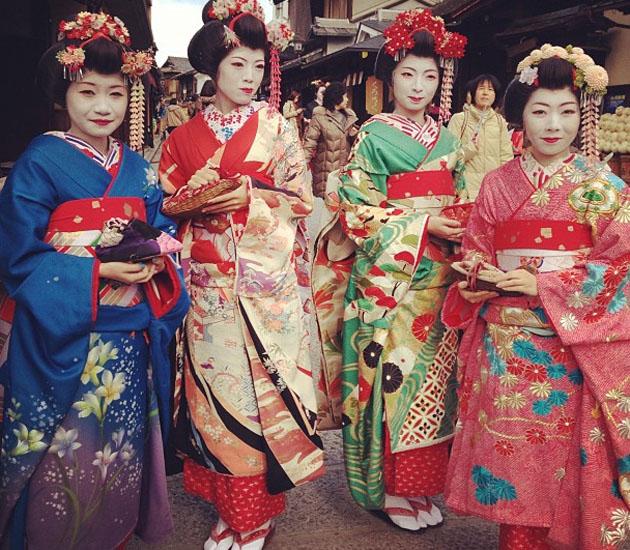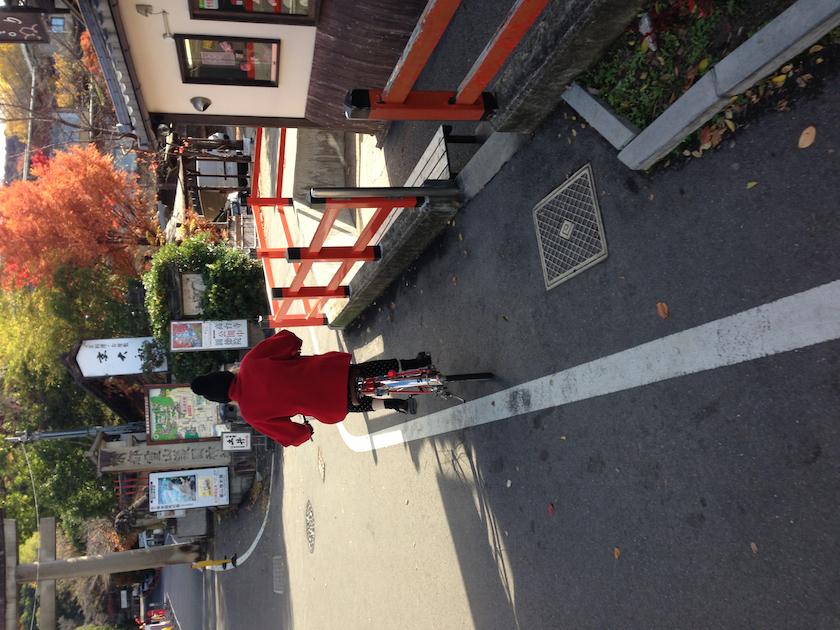
Most people visiting Japan will invariably spend the bulk of time in Tokyo and that’s not a vibe we intend to harsh. In fact, we endeavour to propose a partnership, a chance for equilibrium – the energetic over-stimulation of Tokyo offset by the solace to be found in heritage city Kyoto.
When the country’s vivid capital has sucked from you the will to party and you’ve been exposed adequately to weird and obscure shit, Kyoto will sort you out. A city in the central part of the island of Honshu, the former imperial capital of Japan is the oldest and most traditional area of the country. Renowned for its Buddhist temples and Shinto shrines, bikeable old-world neighbourhoods and traditional cuisines, Kyoto is defeated only by Rome for the largest amount of World Heritage Sites.
The Shinkansen is your ticket to moving swiftly between Tokyo and Kyoto, with this nifty breed of train famously traveling at speeds of up to 270 kilometres per hour. What you want here is the JR Tokaido Shinkansen line, where you can climb aboard a Nozomi train (the fastest kind) and be in Kyoto in around 2 hours and 20 minutes. There are usually four departures per hour in each direction, and tickets are 135,000 yen (approx $132AUD) for a one-way reserved seat. If that’s not the most attractive price, the Hikari or the Kodama train will get you there at slower speeds (still worlds faster than your local city rail) for fewer yen. Sort all that out here, including deliberation about whether or not your itinerary warrants the JR Rail Pass, another potential godsend for tourists.
As with Japan in its entirety, the best times to visit Kyoto are April and November, for cherry blossoms in spring and delightfully coloured foliage in autumn, respectively. Like we said, Tokyo rules – so if you’ve only got a couple of Kyoto days, here’s what we can recommend.
Fushimi Inari Shrine
Address: 68 Fukakusa Yabunouchicho, Fushimi-ku, Kyoto, Kyoto Prefecture 612-0882
Phone: 075- 641-7331
Website: inari.jp
Shinto and Buddhism coexist to form the basis of religion in Japan, and this site belongs to the former. The God of Rice, Inari, is worshipped here, with visitors on a quest for luck with wealth. More laxly known as The “torii gates”, countless tangerine coloured gates (torii) in various shapes form the attraction, tapering from a series of walk-through gates into nestled arrangements for worshipping. A seriously beautiful site, particularly in autumn when the leaves mimic the colour palette.


Kiyomizu-dera Temple
Address: Mt. Otowa, Kyoto, Kyoto Prefecture
Phone: +81 75-551-1234
Website: www.kiyomizudera.or.jp
Possibly the most notorious Buddhist Temple in Kyoto, Kiyomizu-dera sits atop a hill that gives way to some lush views, particularly as the sun sets. Named for the sacred spring that flows from the mountain, kiyo (pure) and mizu (water) comprise the namesake. And oh, for good luck, you can catch and drink the water from the Otowa-no-taki spring (see below), so do that.The wide stone pathway leading to the temple is littered with tourist stores where all your deepest kimono and chopstick desires can be satiated (as opposed to kooky, futuristic souvenirs a la Tokyo). In 2007, Kiyomizu-dera was nominated as one of the New Seven Wonders of The World. Thing is, they didn’t make the cut, oh, what an anticlimax, sorry. Not to worry— there were only 21 nominees, so that’s pretty cool. Aside from that, we’re recommending it along with this stunning imagery, so trust your own eyes and trust in us.


‘Gotta catch them all’, say visitors as they catch the pure waters so that they may quench their thirsts and be lucky.
Arashiyama Bamboo Forest
This district on the western outskirts of Kyoto is famous for the bamboo forest of which we speak. It’s not a huge forest by any definition, but we invite you to visit for reasons of tranquility and serenity. If you find beauty in uniformity as opposed to irregularity, these taaaall, statuesque trees act essentially as a natural tunnel to traipse through as the sun peeks through the leaves. Gorgeous! If you know what’s good for you you’ll take the JR train to Arashiyama station from Kyoto station. Find a walkway leading to the bamboo forest off the main street of Arashiyama. Bliss out maximally, without neglecting pre and post neck stretches. Move onto the following, v. proximal attraction if you like monkeys!

[1]
Arashiyama Monkey Park
Address: 8 Arashiyama Genrokuyama-cho, Nishikyo-ku, Kyoto 616-0007
Hours: 9:00 to 17:00 (until 16:00 in winter)
Website: www.kmpi.co.jp
Home to around 130 wild monkeys, the word ‘zoo’ is an irrelevant descriptor— the word ‘wild’, in fact, should not be taken lightly. With the little guys roaming free, the intent of this park is to replicate the wild habitat of monkeys (all save the fact that they’re fed by park staff to). A special part about this place is you’ll get to hang with a type of monkey known as the Japanese macaque. More simply referred to as the snow monkey, these dudes are the most northern-living as well as the most polar-living non-human primate. A terrestrial, old-world monkey that is scarcely found outside of Kyoto, the website stipulates a few rules around interacting with them (and all kinds of monkeys at the park):
Rule 1. Don’t stare into the monkeys’ eyes— they consider it as a sign of a threat and some of them become aggressive.
Rule 2. Don’t touch the monkeys— like other wild animals, the monkeys hate being touched and feel stress.
Rule 3. Don’t feed them outside the hut surrounded by a wire netting— This encourages them to misbehave to people.
Admission is just 550 yen (a little over five bucks).

Oh hey.
Geisha Spotting
Geisha spotting, sadly, is not as easy as turning up in Japan and spotting geishas. Similarly, we have that misconception re. Australia and free hopping kangaroos— bloody lies, innit? The Gion district in Kyoto, however, is where this game is best played. Preserved streets and traditional wooden merchant houses (machiya) characterise Gion, and fittingly, the traditionally clad geishas hang in these parts. A good time for sightings is 6pm onwards, where the beauties travel in small groups. Else, on Gion Corner, there are organised performances that are in part lead by geishas. The duration is an hour, encompassing Japanese harp (koto), flower arrangement (ikebana), traditional comic play (kyogen), Kyoto style dance (kyomai) and puppet play (bunraku). This fun occurs at 7pm and 8pm daily for 3150 JPY ($31AUD), with more info here.

Find a local walking her pig down a narrow side street
Stumbling across this cutie with its owner (or this cutie with her pet) was a pretty gushy and exciting moment, and I thought to myself ‘rare cultural sighting’. I still sorta maintain that feeling, even though I discovered this picture of THE SAME WOMAN as the first google search result on typing in “walking pet pig in Kyoto”. So maybe there’s only one woman with a pet pig in the whole of Kyoto and maybe you can find her too! Equally exciting would be finding any pet pigs and walkers of them at all. Don’t set a day aside for it or anything but keep your subordinate set of eyes on the prize.

Hire a bike and ride it everywhere
Essentially everything you’ve just read above can be navigated by bicycle, simultaneously advantageous in augmenting fun times and efficiency. Bike rental is inexpensive (around $10AUDish per day) and widely available in Kyoto; consult your hotel as they probably offer it. If you’re not a confident rider, let it be known that the streets of Kyoto have basically no hierarchy— drivers, riders, pedestrians— they all have equal capital (though bike lanes are progressively being implemented). So if ducking and weaving doesn’t make you nervous, and abrupt stop-starting is cool with you, bicycling is the best way to get around the flat streets of Kyoto.

[1] Greg Elms via Lonely Planet



